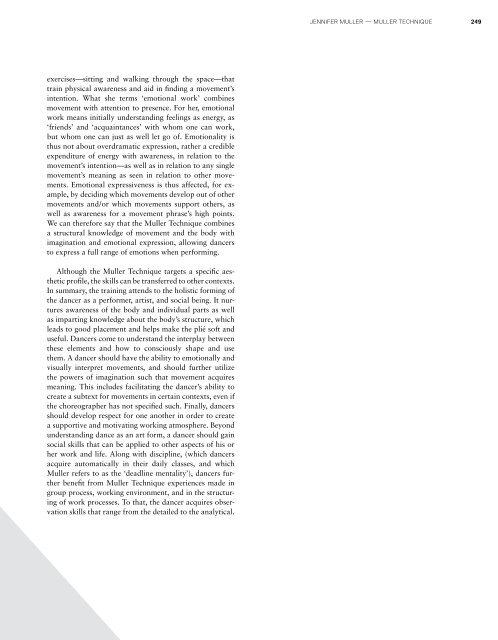Dance Techniques 2010
What does today's contemporary dance training look like? Seven research teams at well known European dance universities have tackled this question by working with and querying some of contemporary dance s most important teachers: Alan Danielson, Humphrey/Limón Tradition, Anouk van Dijk, Countertechnique, Barbara Passow, Jooss Leeder Technique, Daniel Roberts Cunningham Technique, Gill Clarke Minding Motion, Jennifer Muller Muller Technique, Lance Gries Release and Alignment Oriented Techniques. This comprehensive study includes interviews, scholarly contributions, and supplementary essays, as well as video recordings and lesson plans. It provides a comparative look into historical contexts, movement characteristics, concepts, and teaching methods. A workbook with two training DVDs for anyone involved in dance practice and theory. Ingo Diehl, Friederike Lampert (Eds.), Dance Techniques 2010 – Tanzplan Germany. With two DVDs. Berlin: Henschel 2011. ISBN 978-3-89487-689-0 (Englisch) Out of print.
What does today's contemporary dance training look like? Seven research teams at well known European dance universities have tackled this question by working with and querying some of contemporary dance s most important teachers: Alan Danielson, Humphrey/Limón Tradition, Anouk van Dijk, Countertechnique, Barbara Passow, Jooss Leeder Technique, Daniel Roberts Cunningham Technique, Gill Clarke Minding Motion, Jennifer Muller Muller Technique, Lance Gries Release and Alignment Oriented Techniques.
This comprehensive study includes interviews, scholarly contributions, and supplementary essays, as well as video recordings and lesson plans. It provides a comparative look into historical contexts, movement characteristics, concepts, and teaching methods. A workbook with two training DVDs for anyone involved in dance practice and theory.
Ingo Diehl, Friederike Lampert (Eds.), Dance Techniques 2010 – Tanzplan Germany. With two DVDs. Berlin: Henschel 2011. ISBN 978-3-89487-689-0 (Englisch) Out of print.
Create successful ePaper yourself
Turn your PDF publications into a flip-book with our unique Google optimized e-Paper software.
Jennifer Muller — Muller Technique<br />
249<br />
exercises—sitting and walking through the space—that<br />
train physical awareness and aid in finding a movement’s<br />
intention. What she terms ‘emotional work’ combines<br />
movement with attention to presence. For her, emotional<br />
work means initially understanding feelings as energy, as<br />
‘friends’ and ‘acquaintances’ with whom one can work,<br />
but whom one can just as well let go of. Emotionality is<br />
thus not about overdramatic expression, rather a credible<br />
expenditure of energy with awareness, in relation to the<br />
movement’s intention—as well as in relation to any single<br />
movement’s meaning as seen in relation to other movements.<br />
Emotional expressiveness is thus affected, for example,<br />
by deciding which movements develop out of other<br />
movements and / or which movements support others, as<br />
well as awareness for a movement phrase’s high points.<br />
We can therefore say that the Muller Technique combines<br />
a structural knowledge of movement and the body with<br />
imagination and emotional expression, allowing dancers<br />
to express a full range of emotions when performing.<br />
Although the Muller Technique targets a specific aesthetic<br />
profile, the skills can be transferred to other contexts.<br />
In summary, the training attends to the holistic forming of<br />
the dancer as a performer, artist, and social being. It nurtures<br />
awareness of the body and individual parts as well<br />
as imparting knowledge about the body’s structure, which<br />
leads to good placement and helps make the plié soft and<br />
useful. <strong>Dance</strong>rs come to understand the interplay between<br />
these elements and how to consciously shape and use<br />
them. A dancer should have the ability to emotionally and<br />
visually interpret movements, and should further utilize<br />
the powers of imagination such that movement acquires<br />
meaning. This includes facilitating the dancer’s ability to<br />
create a subtext for movements in certain contexts, even if<br />
the choreographer has not specified such. Finally, dancers<br />
should develop respect for one another in order to create<br />
a supportive and motivating working atmosphere. Beyond<br />
understanding dance as an art form, a dancer should gain<br />
social skills that can be applied to other aspects of his or<br />
her work and life. Along with discipline, (which dancers<br />
acquire automatically in their daily classes, and which<br />
Muller refers to as the ‘deadline mentality’), dancers further<br />
benefit from Muller Technique experiences made in<br />
group process, working environment, and in the structuring<br />
of work processes. To that, the dancer acquires observation<br />
skills that range from the detailed to the analytical.


















